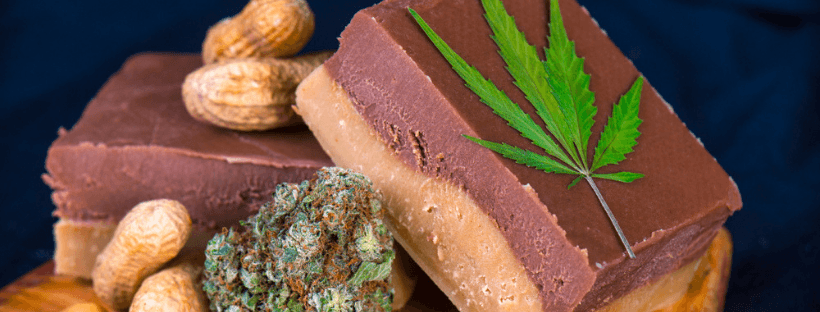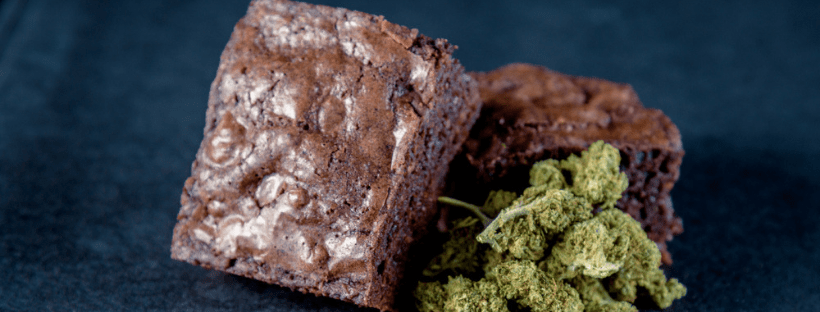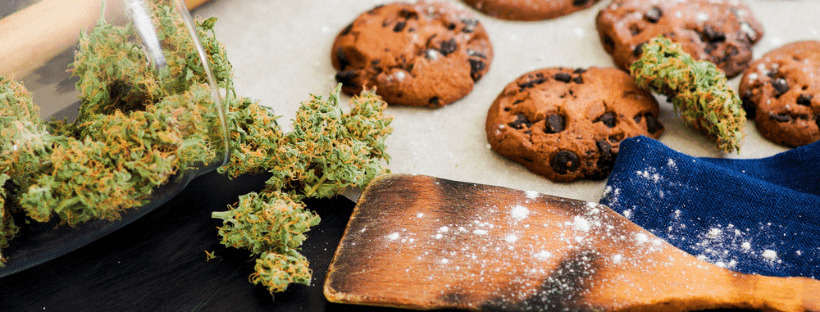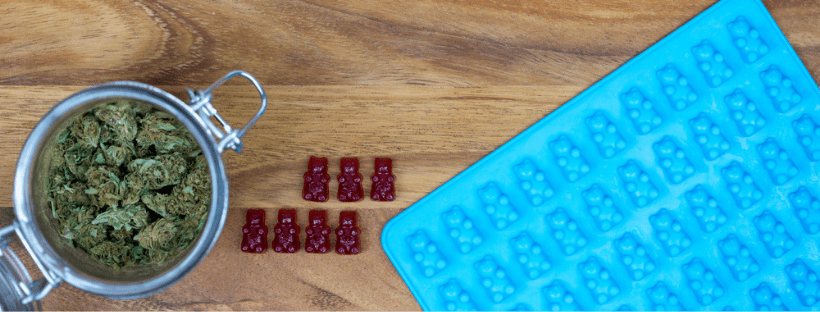Guide to Edibles for Newbies
Oh, edibles.
If you are looking for a smoke-free alternative to consuming cannabis, you may have come across this term. Or, you’ve heard from friends that edibles will knock you on your butt. Maybe just you’re curious after you saw that girl on YouTube who does makeup tutorials after munching down on “special treats.” You could just be hungry and want to kill two birds with one stone. Whatever brings you to the world of edibles doesn’t really matter. Welcome! Use this post as a guide to edibles and a good place to get started.
What are edibles?
Oh boy. If you’re really asking this question, you have a lot to learn. Let’s begin with the basics.
“Edibles” are a name for edible treats that contain some form of cannabis. Users who ingest edibles will generally feel the same effects as they would if they smoked marijuana, but because users ingest the edible as an oil, it will travel through the body differently and offers a different experience.
Cannabis consumers can enjoy edibles in many different forms, including:
- Brownies
- Cookies
- Chocolate bars
- Gummy bears and other gummy snacks
- Rice krispie treats
Why are edibles so versatile? The THC (or CBD) is inside a cooking oil or similar ingredient that is used to make the treat. So if you can get your hands on tincture or a cannabis-infused cooking oil, you can any type of edible that you want. Use cannabis cooking oil to fry up your steaks or make a grilled cheese that soaks up cannabis-infused butter. Go to town.
We’ll talk more about how to make your own edibles later on, but let’s get the basics out of the way first.

Are edibles legal in Canada?
Cannabis is legal in Canada, but the country is still working out the kinks of the different forms of cannabis. Canadians can find edibles online through a handful of licensed retailers, but they may still come into trouble with the law if they try to bring edibles on an airplane or sell edibles at their church bake sale. Federal lawmakers are working on creating legislation that precisely lays out the law regarding edibles, but these won’t go into effect until 2019.
How long does it take for edibles to kick in?
If you remember nothing else from this guide to edibles, remember this:
WAIT ONE HOUR FOR THE EDIBLES TO KICK IN.
We’re going to tell you again so that you don’t forget.
WAIT ONE HOUR FOR THE EDIBLES TO KICK IN.
This is probably the number one thing you will hear after you tell someone you’re going to try edibles for the first time anyway. Why does it take so long for edibles to kick in?
Edibles and smoke travel through the body in different ways. Smokers can feel the effects of THC within minutes; THC only has to travel from the lungs up to the brain. When you eat an edible, you send the THC to your stomach. THC from edibles go through a different process and takes about an hour to hit the brain.
Of course, in that time, you might have gotten impatient or think that the edibles are ineffective. So you took another. Or maybe a third.
Rookie mistake.
After an hour, you’ll be knocked out on your butt and things may start to feel a little freaky. So remember to be patient when you are trying out edibles (or any new type of cannabis product) for the first time.
Do edibles get you higher than smoking?
When you’re impatient for the edibles to kick in and stuff your face with twice the recommended amount, yes. That’s why most people are under the idea that edibles are more powerful than smoking.
Edibles are pretty potent, but there are a lot of reasons why you might experience a more intense high from edibles. When you smoke, you tend to lose a lot of THC as you puff-puff-pass or exhale. In fact, you lose more THC than you inhale. So even when you think you’re packing a lot of weed into your bowl, you’re only getting a fraction of that high. There’s no way to “lose” any of the THC in your edible, unless you try and break the bite-sized treat and get crumbs all over the floor.
A one-hitter gives you about 10mg of THC. So does a single peach candy. So the amount that you are consuming is pretty comparable.
If you decide to make edibles yourself, it may be harder to determine how much THC you are consuming. Each edible that you make may contain a different amount of THC, depending on how big of a piece you take and how well you mixed the edible.
If you want to know more information, we wrote a whole blog post on the debate between edibles and smoking.

Indicas vs. Sativas in Edibles
You may not always be able to tell what strain is in your edible, even if you buy from a licensed retailer in Canada. Some products will let you know what type of cannabis is in the edible or even give you a choice between the same type of edible in a sativa or indica variety. But these choices aren’t always easy to find.
Consumers typically have the choice between whether they want a specific strain or category (indica, sativa, etc.) So why is this less common with edibles?
It all depends on who is making the edible. In some cases, the edible is made from a pure THC distillate or isolate. This allows the dosages to be more precise, but the exact genetic makeup of the strain is hard to track down.
In reality, you might not notice a difference between an edible with indica and an edible with sativa.
Why?
Any type of edible will tend you a “sedating” body high similar to the “couch lock” feeling you may know from a strong indica. But that is due to the chemical makeup of the cannabis, rather than the strain of cannabis that is in the edible. Edibles break down 11-hydroxy-THC in your stomach, which is a chemical compound only similar to THC. This compound creates the body high that you may know and love (or may know and try to avoid.)
There are ways to identify whether you are consuming an indica, sativa, or hybrid edible, but feel free to experiment like you would if you were just trying cannabis for the first time.
Some cannabis lovers may prefer to make cannabis oil at home in order to pick and choose the strains that work best for them. While this is perfectly alright, just know that you may experience different side effects due to the different method of consumption.
How long do edibles stay in your system?
You’re in luck. We also wrote a whole blog post on this subject and why people who take an edible in the evening may feel loopy in the morning. People can’t get hangovers from marijuana, but if the body isn’t able to process the amount of THC in your body as you slumber, you’ll still be soaring when you wake up.
If you are worried about a drug test coming up, you shouldn’t worry as much about the type of weed you consumed, but instead how often you smoke. While occasional smokers can flush THC out of their body in a few days, regular smokers may still test positive for THC up to 70 days after they put down the joint (or cookie.) Different types of chemical tests (urine, saliva, etc.) will also factor into whether you test positive for a long-forgotten joint.
Can you get edibles without THC?
Not everyone who consumes cannabis wants to be locked to the couch for 12 hours. If you want edibles that have CBD but no THC, you can find gummies and other options that won’t get you too high.
Can you make edibles at home?
Yes, but be especially careful. Since Canada has legalized marijuana, cannabis connoisseurs can grow and possess cannabis for personal consumption. If you want to turn your home-grown cannabis plants into cookies for your friends and family, go for it.
There are three main ways to create an edible: with cannabis-infused cooking oil, gummies, or butter.

How To Make Cannabis Cooking Oil
This is one of the most versatile options for infusing cannabis into your food. Feel free to use any cooking oil of your choice, including:
- Olive oil
- Canola oil
- Coconut oil
There are a variety of methods available for making cannabis-infused cooking oil, but most people prefer to use a slow cooker. Slow cookers reduce the risk of burning the THC and tend to mask the smell more than a stovetop.
Gather the following ingredients and add them to your slow cooker:
- One cup of the cooking oil of your choice
- One ounce of the dried bud of your choice
- Four cups of water
(You don’t have to be exact with these measurements. Feel free to add more or less oil depending on how potent your bud is and how potent you would like the oil to be.)
Leave the slow cooker on low for at least four to eight hours. You can certainly add more time to the clock if you desire, but four to eight hours should do. This will give the plant material time to break down and for the THC to combine with the oil. Meanwhile, the ingredients that give your favorite strain its color and flavor profile will bind with water, which you’ll dispose of when the slow cooker is done.
Once time is up, strain all of the ingredients with a cheesecloth. Pour another cup or two of water on the cloth just to make sure you get the most out of your oil. Oil and water separate, so you’ll be able to skim the oil you need off of the top once you set your ingredients aside.
Skim the oil with a spoon or a gravy separator and strain one more time to ensure you only have a smooth liquid for your cooking endeavors. Store the oil in your fridge or freezer and use within three months.
Too much work? You can also buy a cannabis olive oil online.
How to Make Cannabis Butter
If you prefer to spread your cannabis creation on a slice of toast, don’t worry. The steps to making cannabis butter (or “cannabutter”) are very similar to cannabis oil. You can even use the same slow cooker and cheesecloth. (Just make sure they’re clean.)
All you have to do differently is replace the cooking oil with butter. That’s it! Use the same process and scoop the butter out of the mixture and store in the fridge.

How to Make Cannabis Gummies
If you would rather feel chilled out with a weed gummy over hyped up from a jello shot, this recipe is for you. It requires an alcohol tincture, which you can make yourself or buy online. (We recommend buying it online.)
In order to make cannabis gummies, you’ll need the following ingredients:
- One and a half cups of pure fruit juice (none of that stuff from concentrate)
- Four tablespoons of gelatin
- A few tablespoons of raw honey or stevia (optional)
- One tablespoon of tincture
- Molds (it doesn’t matter if it’s bears, rings, something inappropriate…you choose what gummies you want to make!)
Pour the fruit juice into a saucepan and heat on low. When the juice is warm, add the tincture. Slowly add the gelatin and whisk the mixture until everything is dissolved. You can add a tablespoon or two of a sweetener, but only if you have a sweet tooth.
Once you have a mixture that you like, take the saucepan off of the stove and pour the mixture into the molds. Pop the molds the fridge for at least three hours and, voila! You have some delicious cannabis gummies.
One tablespoon of tincture usually contains 15 mg of THC. Use this number to figure out how much THC you have in each individual gummy. (The THC will probably not be distributed evenly.)
Too much work? You can also buy cannabis gummies online.
Enjoy Your Edibles!
Now that you know how to get (and where to get) edibles and cannabis-infused ingredients, go crazy! Experiment with different types of baked goods and spice up your Christmas cookie exchange. As always, it is important to enjoy edibles responsibly.







